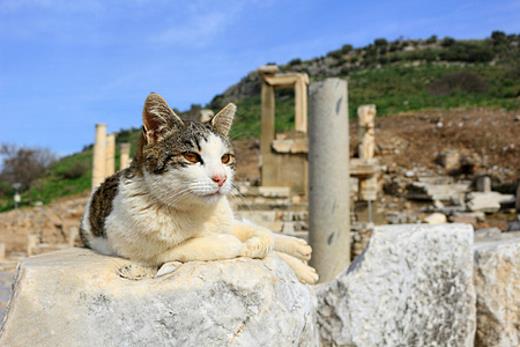People have always had an interesting relationship with cats—unlike with any other animal. Of all the domesticated animals, both farm and companion, cats are the ones who have changed the least.

From one viewpoint, it’s actually a good thing because people often mess things up. It is also hypothesized that cats would likely be the only domestic animals to survive if humans were gone one fine day. Good for them!
But this isn’t a coincidence. The fact that cats are so well adapted to a natural lifestyle and are so close to their wild cousins has a lot to do with when, where and why cats were domesticated.
Where do domestic cats come from?
Is it possible to know where domestic cats come from? What could give us such information? Most would say archaeological findings. In a way, they are right; archaeology alone has provided the largest pieces of the puzzle for everything that we know about the past, from dinosaurs to domestic cats.
If archaeologists discover an ancient burial place in the Valley of the Kings in Egypt and see a drawing of a cat on the wall, they are able to conclude that cats were already domesticated at that time—or at least 4,000 years ago. Egypt, in fact, is a place most of us associate with the earliest domestic cats.
The year 2004 came with a revolutionary finding. A team of French archaeologists discovered a grave in Cyprus. A human grave, with a cat buried just inches away, that was about nine thousand years old.
Since Cyprus is a remote island in the Mediterranean Sea that originally had no cat population, it is assumed that the cat was brought there by humans. But there are still too many questions this discovery cannot answer:
- Had the cat found in the grave been domesticated?
- Why did humans bring a cat to the island of Cyprus?
- From where was it brought?
If palpable evidence cannot provide answers to the above questions, what can? This is where modern biology—especially genetics—comes into play.
Geneticists can fill in the gaps
CSI can convict a murderer by analyzing his saliva enzymes; biologists can discover where cats came from in a similar way.
Scientists from the USA studied the DNA of the modern day domestic cat and several subspecies of its closest cousin—wildcat Felis silvestris. Their findings gave us what archaeology had not been able to tell us all these centuries.
The earliest domestic cats came not from Egypt, not from Crete; their closest cousin of all the closest cousins turned out to be the Near Eastern subspecies of the African wildcat—Felis silvestris lybica—which originated in a region known as the “Fertile Crescent.”
In fact, the name of the region, in which modern day Syria, Israel, Lebanon, Kuwait and Iraq reside, has something to do with a popular hypothesis, which now stands on very firm ground, about why cats were domesticated.
But, before we dive into this, let’s take a look at the biological term “symbiosis.” You have probably heard of it; it refers to two organisms living in a close proximity for the benefit of both. The most notable example of this is a bird eating bugs off of a hippo’s back.
Activists would say that humans, who only seek and destroy, are unable to live under such conditions, with the exception of our gut bacteria, which would kill us if we killed them. But it turns out that we live, or at least used to live, in a symbiotic relationship with cats.
The domestic cat—a farmer’s little helper
The Fertile Crescent, in fact, was named the Fertile Crescent because it was fertile. It was a crescent shaped fertile area in which the first buds of agriculture appeared around ten thousand years ago.
Up until then, humans were living as hunter-gatherers and mostly existed in a “another day, another luncheon” kind of way—you find what you can eat and then eat it.

Agriculture, however, changed all that. We finally had a surplus of food.
When you have a seasonal harvest of grain, you need to store it. And what does stored grain attract? Mice! Granaries became heaven, both literally and figuratively speaking, for mice; they gathered in crowds there. And to which animal do crowds of mice equal paradise? To cats!
This led to a very natural, almost automatic, process of domestication, a domestication where no domestication was actually necessary. Cats chose to live near granaries, and, since they were great at exterminating rodents and preserving grain, humans did not mind that at all.
Unlike other animals that were captured and selectively bred for the specific purposes humans needed, cats were already good at a purpose and fulfilled it without being forced.
So it happened that cats kind of domesticated themselves or maybe they domesticated us or, another maybe, they were not really domesticated at all.
Indeed, cats conform with the general definition of domestication only partially. Domestication is a process through which an animal is changed and shaped to fit human needs better, but this was barely the case for cats.
Maybe, just maybe, we are right to say that our modern day pets are still the same wild animals who chose to tolerate being near humans in exchange for easy food access. Just so, they are like any animals who get to decide and move about by themselves.
